2022 TOYOTA HIGHLANDER warning light
[x] Cancel search: warning lightPage 28 of 568

281-1. For safe use
Extend the shoulder belt so
that it comes fully over the
shoulder, but does not come
into contact with the neck or
slide off the shoulder.
Position the lap belt as low as possible over the hips.
Adjust the position of the
seatback. Sit up straight and
well back in the seat.
Do not twist the seat belt.
■Emergency locking retractor
(ELR)
The retractor will lock the belt during
a sudden stop or on impact. It may
also lock if you lean forward too
quickly. A slow, easy motion will
allow the belt to extend so that you
can move around fully.
■Automatic locking retractor
(ALR)
When a passenger’s shoulder belt is
completely extended and then
retracted even slightly, the belt is
locked in that position and cannot
be extended. This feature is used to
hold the child restraint system
(CRS) firmly. To free the belt again,
fully retract the belt and then pull the
belt out once more. ( P. 5 0 )
■Child seat belt usage
The seat belts of your vehicle were
principally designed for persons of
adult size.
●Use a child restraint system
appropriate for the child, until the
child becomes large enough to
properly wear the vehicle’s seat
belt. ( P. 5 0 )
●When the child becomes large
enough to properl y wear the vehi-
cle’s seat belt, follow the instruc-
tions regarding seat belt usage.
( P. 2 7 )
■Seat belt extender
If your seat belts cannot be fastened
securely because they are not long
enough, a personalized seat belt
extender is available from your Toy-
ota dealer free of charge.
WARNING
●Inspect the seat belt system
periodically. Check for cuts,
fraying, and loose parts. Do not
use a damaged sea t belt until it
is replaced. Damaged seat belts
cannot protect an occupant
from death or serious injury.
●Ensure that the belt and plate
are locked and the belt is not
twisted. If the seat belt does not
function correctly, immediately
contact your Toyota dealer.
●Replace the seat assembly,
including the belts, if your vehi-
cle has been involved in a seri-
ous accident, even if there is no
obvious damage.
●Do not attempt to install,
remove, modify, disassemble or
dispose of the seat belts. Have
any necessary repairs carried
out by your Toyota dealer. Inap-
propriate handling may lead to
incorrect operation.
Correct use of the seat
belts
Page 33 of 568
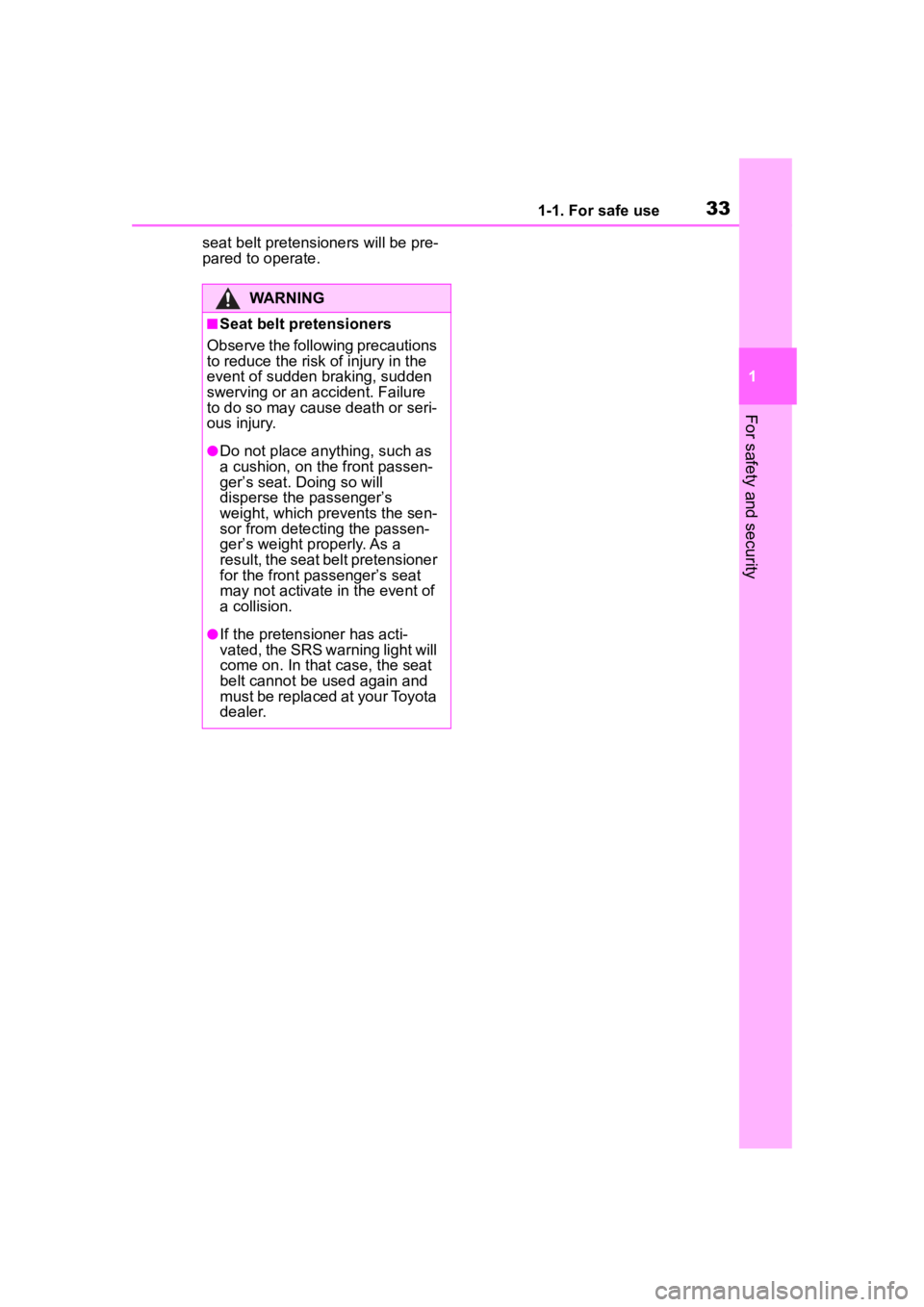
331-1. For safe use
1
For safety and security
seat belt pretensioners will be pre-
pared to operate.
WARNING
■Seat belt pretensioners
Observe the following precautions
to reduce the risk of injury in the
event of sudden braking, sudden
swerving or an accident. Failure
to do so may cause death or seri-
ous injury.
●Do not place anything, such as
a cushion, on the front passen-
ger’s seat. Doing so will
disperse the passenger’s
weight, which prevents the sen-
sor from detecting the passen-
ger’s weight properly. As a
result, the seat belt pretensioner
for the front passenger’s seat
may not activate in the event of
a collision.
●If the pretensioner has acti-
vated, the SRS warning light will
come on. In that case, the seat
belt cannot be used again and
must be replaced at your Toyota
dealer.
Page 35 of 568

351-1. For safe use
1
For safety and security
SRS curtain shield airbags
• Can help protect primarily the head of occupants in the outer seats
• Can help prevent the occupants from being thrown from the vehi cle in the
event of vehicle rollover
■SRS airbag system components
Front passenger airbag
“PASS AIR BAG ON” and “PASS AIR BAG OFF” indicator lights
Front side airbags
Curtain shield airbags
Side impact sensors (rear)
SRS warning light
Front passenger occupant classification system (ECU and sen-
sors)
Driver airbag
Side impact sensors (front door)
Side impact sensors (front)
Seat belt pretensioners and force limiters
Seat cushion airbag
Driver’s seat position sensor
Driver’s knee airbag
Driver’s seat bel t buckle switch
Front impact sensors
Page 40 of 568
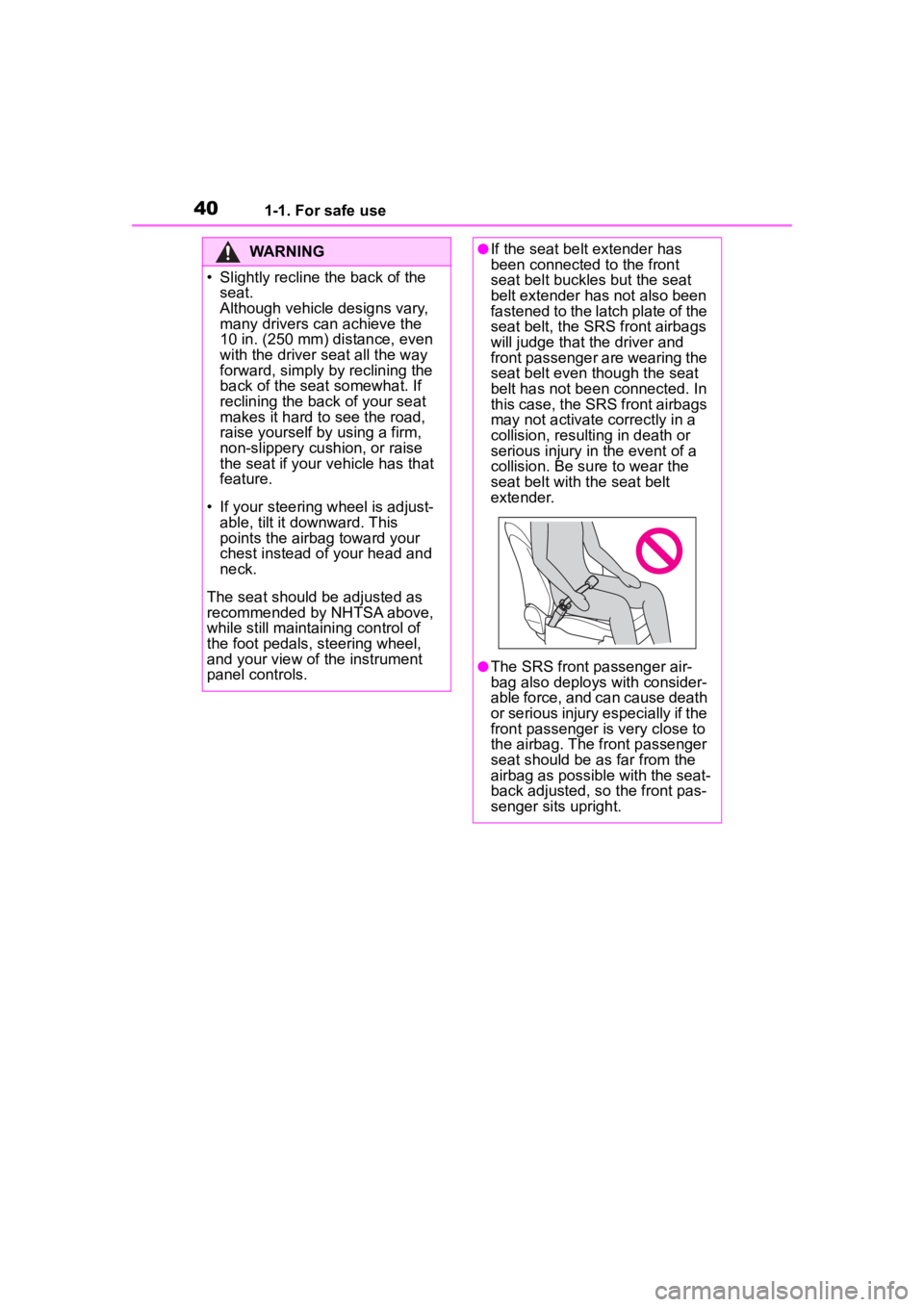
401-1. For safe use
WARNING
• Slightly recline the back of the seat.
Although vehicle designs vary,
many drivers can achieve the
10 in. (250 mm) distance, even
with the driver seat all the way
forward, simply by reclining the
back of the seat somewhat. If
reclining the back of your seat
makes it hard to see the road,
raise yourself by using a firm,
non-slippery cushion, or raise
the seat if your vehicle has that
feature.
• If your steering wheel is adjust- able, tilt it downward. This
points the airbag toward your
chest instead of your head and
neck.
The seat should be adjusted as
recommended by NHTSA above,
while still maintaining control of
the foot pedals, steering wheel,
and your view of the instrument
panel controls.
●If the seat belt extender has
been connected to the front
seat belt buckles but the seat
belt extender has not also been
fastened to the latch plate of the
seat belt, the SRS front airbags
will judge that the driver and
front passenger are wearing the
seat belt even though the seat
belt has not been connected. In
this case, the SRS front airbags
may not activate correctly in a
collision, resulting in death or
serious injury in the event of a
collision. Be su re to wear the
seat belt with the seat belt
extender.
●The SRS front passenger air-
bag also deploys with consider-
able force, and can cause death
or serious injury especially if the
front passenger is very close to
the airbag. The front passenger
seat should be as far from the
airbag as possible with the seat-
back adjusted, so the front pas-
senger sits upright.
Page 43 of 568

431-1. For safe use
1
For safety and security
Vehicles with a 8-inch displaySRS warning light
Driver’s and front passen-
ger’s seat belt reminder light
“PASS AIR BAG OFF” indica-
tor light
WARNING
●Modifications to the front door
panel (such as making a hole in
it)
●Repairs or modifications of the
front fender, front bumper, or
side of the occ upant compart-
ment
●Installation of a grille guard (bull
bars, kangaroo bar, etc.), snow
plows, winches or roof luggage
carrier
●Modifications to the vehicle’s
suspension system
●Installation of electronic devices
such as mobile two-way radios
and CD players
●Modifications to your vehicle for
a person with a physical disabil-
ity
Front passenger occu-
pant classification
system
Your vehicle is equipped
with a front passenger
occupant classification sys-
tem. This system detects
the conditions of the front
passenger seat and acti-
vates or deactivates the
front passenger airbag and
seat cushion airbag.
System components
Page 44 of 568
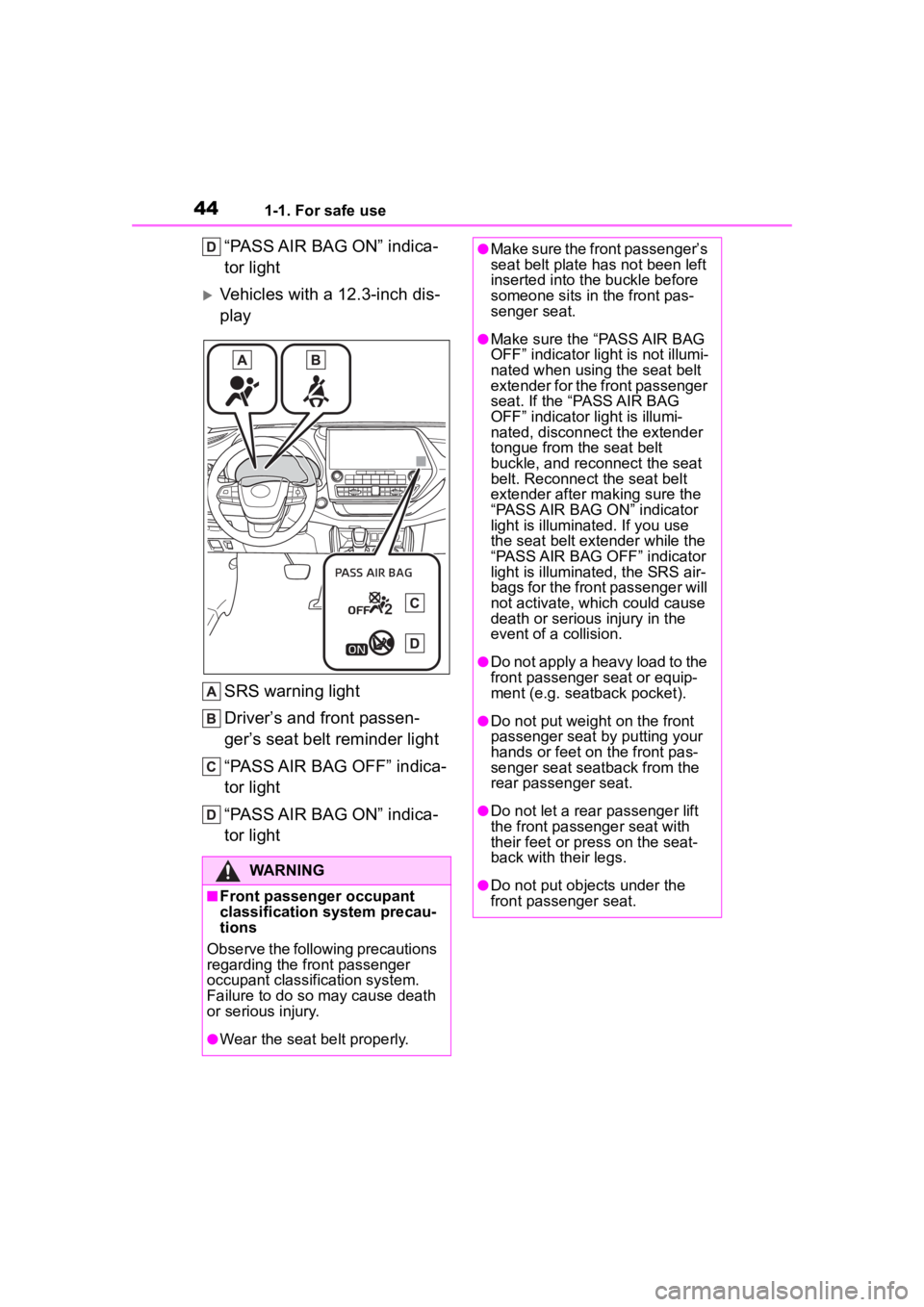
441-1. For safe use
“PASS AIR BAG ON” indica-
tor light
Vehicles with a 12.3-inch dis-
playSRS warning light
Driver’s and front passen-
ger’s seat belt reminder light
“PASS AIR BAG OFF” indica-
tor light
“PASS AIR BAG ON” indica-
tor light
WARNING
■Front passenger occupant
classification system precau-
tions
Observe the following precautions
regarding the front passenger
occupant classification system.
Failure to do so may cause death
or serious injury.
●Wear the seat belt properly.
●Make sure the front passenger’s
seat belt plate has not been left
inserted into the buckle before
someone sits in the front pas-
senger seat.
●Make sure the “PASS AIR BAG
OFF” indicator light is not illumi-
nated when using the seat belt
extender for the front passenger
seat. If the “PASS AIR BAG
OFF” indicator light is illumi-
nated, disconnect the extender
tongue from the seat belt
buckle, and reconnect the seat
belt. Reconnect the seat belt
extender after making sure the
“PASS AIR BAG ON” indicator
light is illuminated. If you use
the seat belt extender while the
“PASS AIR BAG OFF” indicator
light is illuminated, the SRS air-
bags for the front passenger will
not activate, which could cause
death or serious injury in the
event of a collision.
●Do not apply a heavy load to the
front passenger seat or equip-
ment (e.g. seatback pocket).
●Do not put weigh t on the front
passenger seat by putting your
hands or feet on the front pas-
senger seat seatback from the
rear passenger seat.
●Do not let a rea r passenger lift
the front passenger seat with
their feet or press on the seat-
back with their legs.
●Do not put objects under the
front passenger seat.
Page 45 of 568
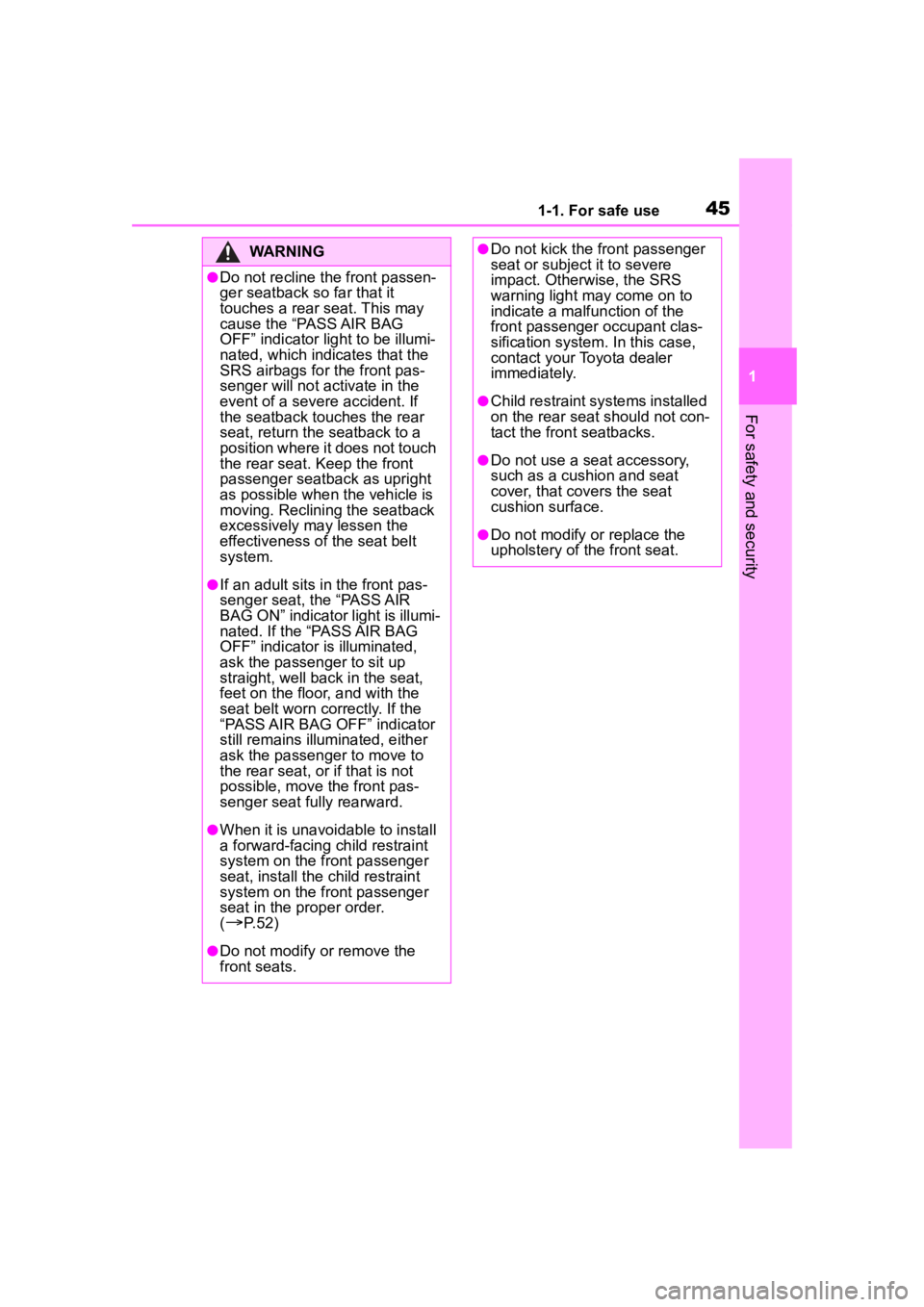
451-1. For safe use
1
For safety and security
WARNING
●Do not recline the front passen-
ger seatback so far that it
touches a rear seat. This may
cause the “PASS AIR BAG
OFF” indicator light to be illumi-
nated, which indicates that the
SRS airbags for the front pas-
senger will not activate in the
event of a severe accident. If
the seatback touches the rear
seat, return the seatback to a
position where it does not touch
the rear seat. Keep the front
passenger seatback as upright
as possible when the vehicle is
moving. Reclining the seatback
excessively may lessen the
effectiveness o f the seat belt
system.
●If an adult sits in the front pas-
senger seat, the “PASS AIR
BAG ON” indicator light is illumi-
nated. If the “PASS AIR BAG
OFF” indicator is illuminated,
ask the passen ger to sit up
straight, well back in the seat,
feet on the floor, and with the
seat belt worn correctly. If the
“PASS AIR BAG OFF” indicator
still remains illuminated, either
ask the passenger to move to
the rear seat, or if that is not
possible, move the front pas-
senger seat fully rearward.
●When it is unavoidable to install
a forward-facing child restraint
system on the fr ont passenger
seat, install the child restraint
system on the fr ont passenger
seat in the proper order.
(
P. 5 2 )
●Do not modify or remove the
front seats.
●Do not kick the front passenger
seat or subject it to severe
impact. Otherwise, the SRS
warning light m ay come on to
indicate a malfu nction of the
front passenger occupant clas-
sification system. In this case,
contact your Toyota dealer
immediately.
●Child restraint systems installed
on the rear seat should not con-
tact the front seatbacks.
●Do not use a seat accessory,
such as a cushion and seat
cover, that covers the seat
cushion surface.
●Do not modify or replace the
upholstery of the front seat.
Page 46 of 568
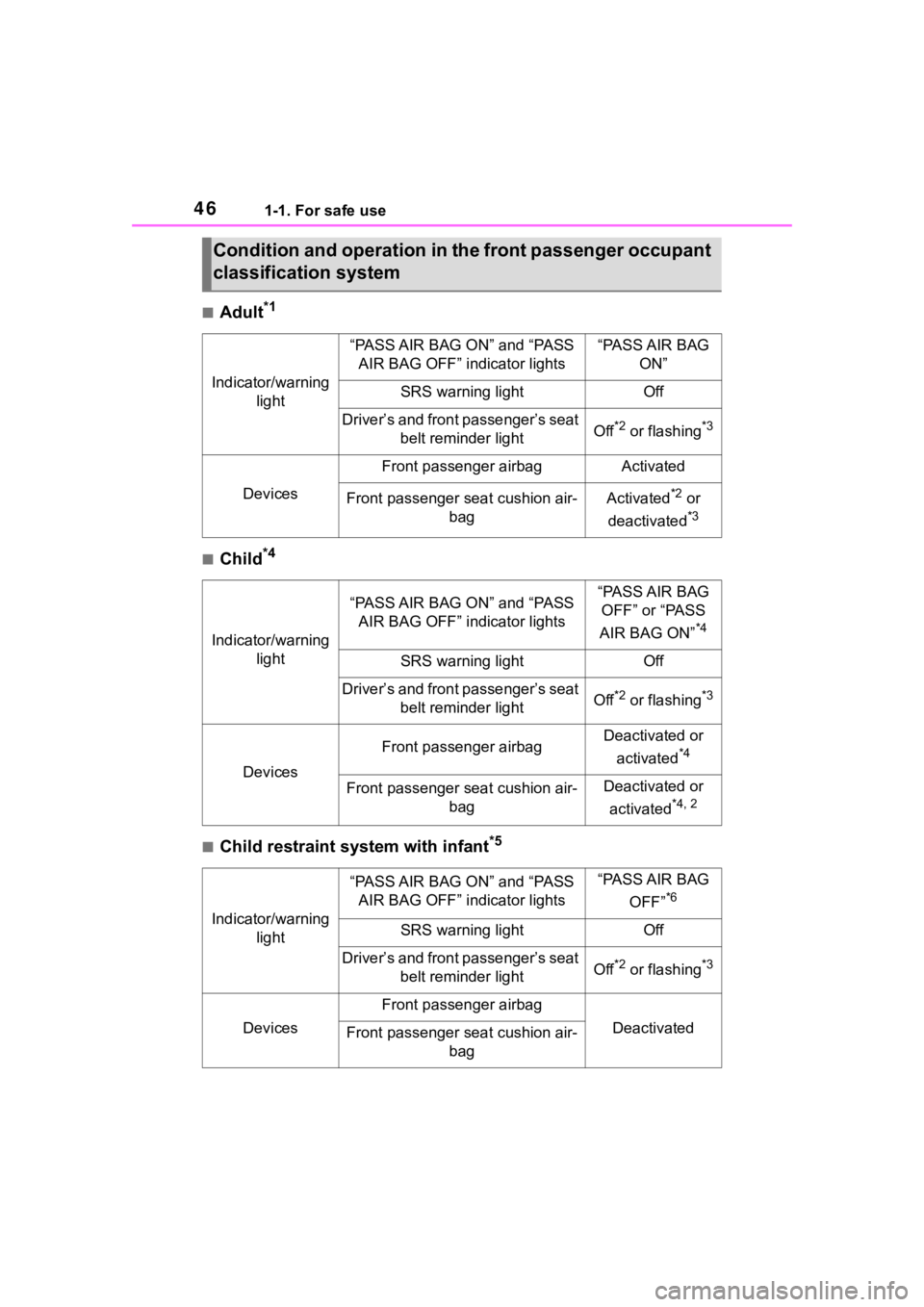
461-1. For safe use
■Adult*1
■Child*4
■Child restraint system with infant*5
Condition and operation in the front passenger occupant
classification system
Indicator/warning light
“PASS AIR BAG ON” and “PASS AIR BAG OFF” indicator lights“PASS AIR BAG ON”
SRS warning lightOff
Driver’s and front passenger’s seat belt reminder lightOff*2 or flashing*3
Devices
Front passenger airbagActivated
Front passenger seat cushion air- bagActivated*2 or
deactivated
*3
Indicator/warning light
“PASS AIR BAG ON” and “PASS AIR BAG OFF” indicator lights“PASS AIR BAG OFF” or “PASS
AIR BAG ON”
*4
SRS warning lightOff
Driver’s and front passenger’s seat belt reminder lightOff*2 or flashing*3
Devices
Front passenger airbagDeactivated or
activated
*4
Front passenger seat cushion air- bagDeactivated or
activated
*4, 2
Indicator/warning light
“PASS AIR BAG ON” and “PASS AIR BAG OFF” indicator lights“PASS AIR BAG
OFF”
*6
SRS warning lightOff
Driver’s and front passenger’s seat belt reminder lightOff*2 or flashing*3
Devices
Front passenger airbag
DeactivatedFront passenger seat cushion air- bag